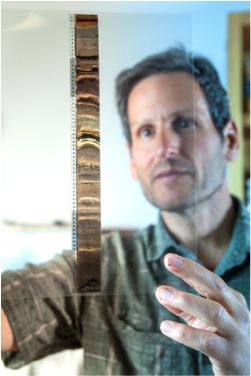by Darrell Kaufman, Regents’ Professor, School of Earth Sciences & Environmental Sustainability
When human-caused climate change first emerged as a serious concern 30 years ago, geoscientists had barely entered into the discussion. At that time, they had little more to contribute than a curious footnote: Climate changes have occurred in the past. Now, reconstructions of past global changes serve as challenging targets for sophisticated computerized models of Earth’s climate.
Geoscientists interrogate the clues left by past climate changes to determine what, when, where and why it happened.
What happened: Geoscientists use a remarkable set of tools to deduce what happened in the past. They retrieve cylinders of ice from kilometers-thick glaciers to analyze the composition of ancient air trapped in bubbles. They extract microfossils from mud lifted from the deepest ocean to decode past sea-level changes. They sample trees, corals and rodent middens to determine how organisms have responded to past climate changes. And they map the shorelines etched onto the landscape by fluctuating lake levels.
When it happened: To paint an accurate picture of past climate changes, geologic records must be placed on an accurate timeline. Radioactive decay is earth’s primary chronometer. The growth bands of trees and corals, like the rhythmic layering of glacier ice and lake mud, mark the cycle of the seasons. Ash erupted by explosive volcanoes leave telltale deposits across the landscape. Even the symmetry of amino acids preserved in fossils evolves systematically with the passage of time.
Where it happened: The spatial pattern of climate change can reveal a lot about what caused it. The ocean and atmosphere circulate heat around the planet in geographic patterns that shift with global climate itself. These patterns affect large regions, and no single site tells the whole story. To gain a complete picture of past climate changes geoscientists collaborate on the global patterns of climate change.
Why it happened: The causes of climate change are already relatively well known, especially how greenhouse gasses govern the energy balance of the atmosphere. But climate involves more than the composition of the atmosphere. Other components of the Earth system, including the oceans, biosphere and ice, all interact in ways that determine the course of change. To understand these longer-term fluctuations requires a perspective that transcends the space and time of most daily human experience. It requires a long-term and global view of climate.
Taking Earth’s Temperature: Delving into Climate’s Past, a one-hour documentary produced by NAU’s IDEA Lab which features Darrell Kaufman’s research about past climate changes, is scheduled to air at 6 p.m. Saturday, Sept. 20, on Phoenix’s KAET (Channel 8).



